Brick is the vital element of any building construction. To make the building durable, the quality of the brick should be judged well.
Given the below the detailed lists of tests to detect the quality of bricks. Among these tests, some are done in laboratory and the remains are on the jobsite.
Compressive strength test
Water Absorption test
Efflorescense test
Hardness test
Size, Shape and Color test
Soundness test
Structure test
Compressive strength test: This test is executed to find out the compressive strength of brick. It is also known as crushing strength of brick. Usually 5 specimens of bricks are transmitted to laboratory for testing and tested separately. Under this test a brick specimen is provided to a crushing machine and applied pressure unless it breaks. The extreme pressure that is liable for brick crushing is also considered. All five brick specimens are verified separately and average result is treated as brick's compressive/crushing strength.
Water Absorption test: Under this test bricks are weighed in dry condition. Then the bricks are submerged in fresh water for 24 hours. Once the 24 hours are completed, these are withdrawn from water and expunge with cloth. Again the brick is weighed in wet condition. The variance between weights denotes the water immersed by brick. Then the estimation is made for the percentage of water absorption.
If the brick consumes less water, the quality of the brick will be better. Good quality brick doesn't consume more than 20% water concerning its own weight.
Efflorescense test: If the bricks contain alkalies, it is injurious as they develop a gray or white coating on brick surface through moisture absorption. This type of test is useful to detect the availability of alkalis in bricks. Under this test a brick is submerged in fresh water for 24 hours and then it's withdrawn from water and kept to be dried in shade.
If the whitish coat is invisible on surface, it ensures that no alkalis are present in brick. If the whitish coat is detectable about 10% of brick surface then the existence of alkalis is in tolerable range. If it is about 50% of surface then it may be reasonable. If the alkalis are available more than 50% then the brick is rigorously influenced with alkalies.
Hardness test: Under this test, the brick surface is scratched with a solid thing and if the brick is unaffected, then the quality of the brick is good.
Size, shape and color test: Under this test, arbitrarily collected 20 bricks are demarcated as per length, width and height and then those are computed to obtain the deviation of sizes according to standard. Bricks are carefully monitored to verify if its edges are sharp and straight and undeviating in shape. A superior quality brick must contain bright and unvarying color throughout.
Soundness test: Under this test two bricks are retained with both hands and hit with one another. If there is apparent metallic ringing sound and the bricks don't break then the quality of bricks are good.
Structure test: Under this test, a brick is cracked or a cracked brick is gathered and narrowly inspected. If there exist any flows, cracks or holes on that cracked face then that refers to inferior quality brick.
Ref : www.acivilengineer.com

~~~~~~~~~~~~~~~~~~~~~
Published By
Rajib Dey
~~~~~~~~~~~~~~~~~~~~~
No comments:
Post a Comment